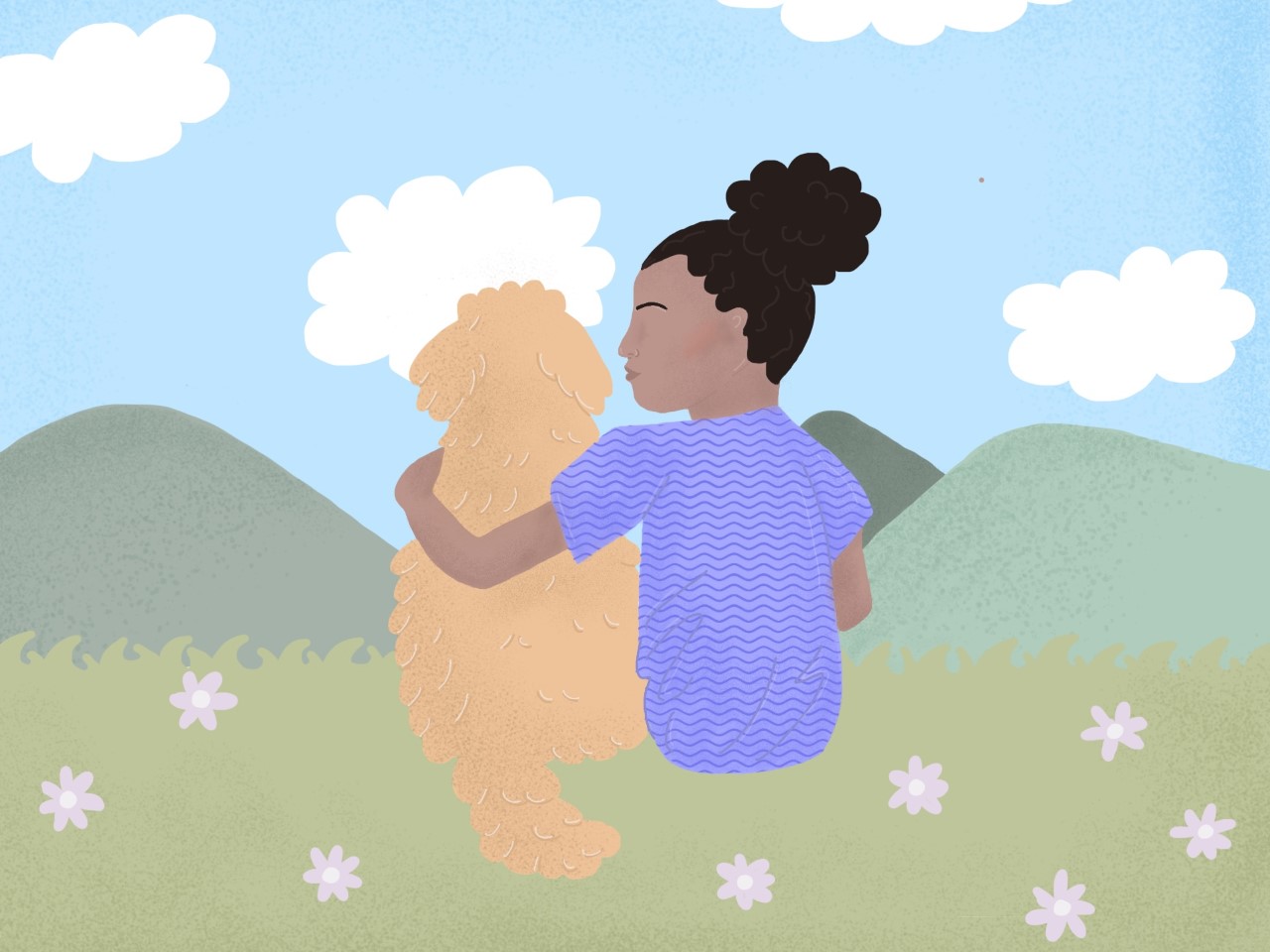
Animals play a crucial role in our lives. From stray animals that provide companionship in a lonely city to cat videos on Youtube that melt the hearts of millions; animals truly are our best friend. This article discusses the ever-growing ways in which animals comfort humans.
Animals play a crucial role in our lives. From stray animals that provide companionship in a lonely city to cat videos on Youtube that melt the hearts of millions; animals truly are our best friend. This article discusses the ever-growing ways in which animals comfort humans.

Illustration by Arianna Cavalli

Illustration by Arianna Cavalli
Feeling lonely? Snuggle with your dog. Feeling sad? Watch cat videos. Feeling stressed? Watch your fish swim. During tough times, we’ve often turned to animals for companionship and support. In fact, a recent study revealed that in our increasingly urban world, there is a growing need for animal companions to combat feelings of isolation and solitude (Wong et al., 2019). With the Covid-19 pandemic, the worldwide rise in protests and the war on Ukraine, this past year has been a flurry of unpredictable events and as a result, emotions. However, time after time, animals have proven to be a consistent and calming source of comfort (Brooks et al., 2018). For instance, photos from the Ukrainian war depict children and adults cradling their pets during a time of rampant conflict and terror – these pets are a connection to their once vibrant lives and homes that are now stained with strife (Bičanski, 2022).
There are various ways in which pets can help individuals experiencing mental health issues: owning a pet is associated with improved physical activity, distraction from the individual’s symptoms, ameliorated social interactions and a sense of purpose (Brooks et al., 2018). While many animals provide solace, certain animals can be classified into two types – service animals and emotional support animals. Both these animals can be obtained via a psychiatrist’s recommendation and are meant to alleviate distress, with emotional support animals being especially useful for people who experience anxiety or depression. The sole difference between the two classes is that service animals have been trained to aid individuals with disabilities with particular tasks such as reminding the person to take their medication (Cherry, 2021).
Taking this a step further, research has demonstrated the considerable benefits of animal-assisted therapy in the treatment of survivors of post-traumatic stress disorder (PTSD). In one study, the presence of dogs led to a 82% reduction in PTSD patients’ symptoms (Mims & Waddell, 2016). Moreover, another study seeking the relation between animal assisted interventions and PTSD symptoms found that post-intervention, PTSD symptoms faced a significant reduction (Hediger, 2021). While the previous two studies were conducted with adults, these results seem to hold true for children as well, particularly children who have experienced childhood sexual abuse. For these individuals, cognitive therapy is not an effective form of symptom reduction. Instead, animal-assisted therapy has proven to be helpful in expediting the treatment process with findings confirming significant decreases in trauma symptoms (including PTSD) of children who had frequently interacted with therapy dogs as opposed to others (Dietz, 2012).
“Animals are a cornerstone of human culture, connectivity and social identity - they bring us closer - to ourselves and to others.”
Apart from individuals with certain mental health conditions, animal-assisted therapy has also proven to be effective for neuro-divergent individuals, specifically those on the autism spectrum disorder. This could be attributed to a unique quality of companion animals: they do not overstep boundaries, which is helpful for people with autism. Setting boundaries can aid autistic individuals’ understanding of social situations and cues, helping themselves and their peers feel comfortable. As mentioned previously, animals increase social interaction and communication and these effects are prominent in autistic individuals who can have difficulties in these respects (O’Haire, 2013). This has been highlighted in a case study investigating the effects of animal-assisted play therapy (AAPT) on social communication in a 7-year-old boy with autism. The research took place over multiple sessions and exhibited increased social communication and decreased stress in the boy after AAPT, with these results remaining true even at the follow-up period (Fung, 2015). These results clearly signal a positive effect of animals on social communication in autistic children and are further supported by another study that presented the efficacy of animal-assisted therapy in improving the socio-emotional skills of children with autism, such as better emotional regulation and expression (Grigore & Bazgan, 2017).
While these positive results hold true for autistic children, there is little evidence regarding the effect of animal therapy on autistic adults. On the other hand, there is strong evidence that animals are valuable companions for the (neuro-typical) elderly. A review suggested that pets, in particular, pet-facilitated therapy can contribute to feelings of comfort and renewed independence in elderly people (Brickel, 1981). Pets can act as a source of entertainment by boosting morale, provide physical comfort, promote exercise and general health, and create a sense of safety for older adults (Erickson, 1985). Personally, I have seen this optimism in my grandmother after she got a dog – she laughs more often and is rarely agitated. Further research into these positive outcomes has led to an important finding: pet ownership, specifically dogs, may lead to improved health and self-care in individuals aged over 60 (Dembicki & Anderson, 1995). An obvious reason for this is that dog owners walk significantly longer than non-owners. However, this finding also brings attention to an important question: Does the species of a pet matter in its positive consequences on the elderly? The answer seems to be yes. The pet owned by senior citizens must be ‘non-demanding, unburden-some, calm, cuddly and non-threatening’ (Erickson, 1985) so owner-pet ties can be established and honoured in the long-run.
In these ways, animals prove to be a source of comfort and warmth for humans. Animals are a cornerstone of human culture, connectivity and social identity – they bring us closer – to ourselves and to others. So, next time you’re feeling a little blue, remember to watch “The Funniest Cat Videos on the Internet!”.
References
-
Bičanski, M. (2022, March 15). Pets of war: Ukrainians take comfort from their animals as they flee the conflict – in pictures. The Guardian. Retrieved November 4, 2022, from https://www.theguardian.com/global-development/gallery/2022/mar/15/pets-of-war-ukrainians-take-comfort-from-their-animals-as-they-flee-the-conflict-in-pictures
-
Brickel, C. (1981). A Review of the Roles of Pet Animals in Psychotherapy and with the Elderly. The International Journal of Aging and Human Development, 12(2), 119-128. https://journals.sagepub.com/doi/abs/10.2190/W4LL-P7PJ-XG1C-2M5M
-
Brooks, H., Rushton, K., & Lovell, K. (2018, February 5). The power of support from companion animals for people living with mental health problems: a systematic review and narrative synthesis of the evidence – BMC Psychiatry. BMC Psychiatry. Retrieved November 4, 2022, from https://bmcpsychiatry.biomedcentral.com/articles/10.1186/s12888-018-1613-2
-
Cherry, K. (2021, June 27). What Is an Emotional Support Animal? Verywell Mind. Retrieved November 3, 2022, from https://www.verywellmind.com/what-is-an-emotional-support-animal-4171479#toc-emotional-vs-service-animals
-
Dembicki, D., & Anderson, J. (1995). Pet Ownership May Be a Factor in Improved Health of the Elderly. Journal of Nutrition For the Elderly, 15(3), 15-31. https://www.tandfonline.com/doi/abs/10.1300/J052v15n03_02?src=recsys
-
Dietz, T. (2012). Evaluating Animal-Assisted Therapy in Group Treatment for Child Sexual Abuse. Journal of Child Sexual Abuse, 21(6), 665. https://www.tandfonline.com/doi/full/10.1080/10538712.2012.726700?src=recsys
-
Erickson, R. (1985). Companion Animals and the Elderly. Geriatric Nursing. https://core.ac.uk/download/pdf/82547316.pdf
-
Fung, S. C. (2015). Increasing the Social Communication of a Boy With Autism Using Animal-assisted Play Therapy: A Case Report. Advances in Mind-body Medicine, 29(3), 27-31. https://europepmc.org/article/med/26026154
-
Grigore, A., & Bazgan, M. (2017). EFFECTS OF ASSISTED ANIMAL THERAPY ON THE DEVELOPMENT OF SOCIO-EMOTIONAL ABILITIES OF CHILDREN WITH AUTISM. Bulletin of the Transilvania University of Braşov, 10(2), 20. http://webbut2.unitbv.ro/BU2017/Series%20VII/CPPETT/26_Grigore.pdf
-
Hediger, K. (2021). Effectiveness of animal-assisted interventions for children and adults with post-traumatic stress disorder symptoms: a systematic review and meta-analysis. European Journal of Psychotraumatology, 12(1), 15. https://www.tandfonline.com/doi/full/10.1080/20008198.2021.1879713?src=recsys
-
Mims, D., & Waddell, R. (2016). Animal Assisted Therapy and Trauma Survivors. Journal of Evidence-Informed Social Work, 13(5), 452. https://www.tandfonline.com/doi/full/10.1080/23761407.2016.1166841?needAccess=true
-
O’Haire, M. (2013). Animal-assisted intervention for autism spectrum disorder: a systematic literature review. Journal of Autism and Developmental Disorders, 43(7), 50. https://europepmc.org/article/MED/23124442
-
Wong, P., Yu, R., & Ngai, J. (2019). Companion Animal Ownership and Human Well-Being in a Metropolis-The Case of Hong Kong. International journal of environmental research and public health, 10(1729), 10. https://www.ncbi.nlm.nih.gov/pmc/articles/PMC6571622/
Feeling lonely? Snuggle with your dog. Feeling sad? Watch cat videos. Feeling stressed? Watch your fish swim. During tough times, we’ve often turned to animals for companionship and support. In fact, a recent study revealed that in our increasingly urban world, there is a growing need for animal companions to combat feelings of isolation and solitude (Wong et al., 2019). With the Covid-19 pandemic, the worldwide rise in protests and the war on Ukraine, this past year has been a flurry of unpredictable events and as a result, emotions. However, time after time, animals have proven to be a consistent and calming source of comfort (Brooks et al., 2018). For instance, photos from the Ukrainian war depict children and adults cradling their pets during a time of rampant conflict and terror – these pets are a connection to their once vibrant lives and homes that are now stained with strife (Bičanski, 2022).
There are various ways in which pets can help individuals experiencing mental health issues: owning a pet is associated with improved physical activity, distraction from the individual’s symptoms, ameliorated social interactions and a sense of purpose (Brooks et al., 2018). While many animals provide solace, certain animals can be classified into two types – service animals and emotional support animals. Both these animals can be obtained via a psychiatrist’s recommendation and are meant to alleviate distress, with emotional support animals being especially useful for people who experience anxiety or depression. The sole difference between the two classes is that service animals have been trained to aid individuals with disabilities with particular tasks such as reminding the person to take their medication (Cherry, 2021).
Taking this a step further, research has demonstrated the considerable benefits of animal-assisted therapy in the treatment of survivors of post-traumatic stress disorder (PTSD). In one study, the presence of dogs led to a 82% reduction in PTSD patients’ symptoms (Mims & Waddell, 2016). Moreover, another study seeking the relation between animal assisted interventions and PTSD symptoms found that post-intervention, PTSD symptoms faced a significant reduction (Hediger, 2021). While the previous two studies were conducted with adults, these results seem to hold true for children as well, particularly children who have experienced childhood sexual abuse. For these individuals, cognitive therapy is not an effective form of symptom reduction. Instead, animal-assisted therapy has proven to be helpful in expediting the treatment process with findings confirming significant decreases in trauma symptoms (including PTSD) of children who had frequently interacted with therapy dogs as opposed to others (Dietz, 2012).
“Animals are a cornerstone of human culture, connectivity and social identity - they bring us closer - to ourselves and to others.”
Apart from individuals with certain mental health conditions, animal-assisted therapy has also proven to be effective for neuro-divergent individuals, specifically those on the autism spectrum disorder. This could be attributed to a unique quality of companion animals: they do not overstep boundaries, which is helpful for people with autism. Setting boundaries can aid autistic individuals’ understanding of social situations and cues, helping themselves and their peers feel comfortable. As mentioned previously, animals increase social interaction and communication and these effects are prominent in autistic individuals who can have difficulties in these respects (O’Haire, 2013). This has been highlighted in a case study investigating the effects of animal-assisted play therapy (AAPT) on social communication in a 7-year-old boy with autism. The research took place over multiple sessions and exhibited increased social communication and decreased stress in the boy after AAPT, with these results remaining true even at the follow-up period (Fung, 2015). These results clearly signal a positive effect of animals on social communication in autistic children and are further supported by another study that presented the efficacy of animal-assisted therapy in improving the socio-emotional skills of children with autism, such as better emotional regulation and expression (Grigore & Bazgan, 2017).
While these positive results hold true for autistic children, there is little evidence regarding the effect of animal therapy on autistic adults. On the other hand, there is strong evidence that animals are valuable companions for the (neuro-typical) elderly. A review suggested that pets, in particular, pet-facilitated therapy can contribute to feelings of comfort and renewed independence in elderly people (Brickel, 1981). Pets can act as a source of entertainment by boosting morale, provide physical comfort, promote exercise and general health, and create a sense of safety for older adults (Erickson, 1985). Personally, I have seen this optimism in my grandmother after she got a dog – she laughs more often and is rarely agitated. Further research into these positive outcomes has led to an important finding: pet ownership, specifically dogs, may lead to improved health and self-care in individuals aged over 60 (Dembicki & Anderson, 1995). An obvious reason for this is that dog owners walk significantly longer than non-owners. However, this finding also brings attention to an important question: Does the species of a pet matter in its positive consequences on the elderly? The answer seems to be yes. The pet owned by senior citizens must be ‘non-demanding, unburden-some, calm, cuddly and non-threatening’ (Erickson, 1985) so owner-pet ties can be established and honoured in the long-run.
In these ways, animals prove to be a source of comfort and warmth for humans. Animals are a cornerstone of human culture, connectivity and social identity – they bring us closer – to ourselves and to others. So, next time you’re feeling a little blue, remember to watch “The Funniest Cat Videos on the Internet!”.
References
-
Bičanski, M. (2022, March 15). Pets of war: Ukrainians take comfort from their animals as they flee the conflict – in pictures. The Guardian. Retrieved November 4, 2022, from https://www.theguardian.com/global-development/gallery/2022/mar/15/pets-of-war-ukrainians-take-comfort-from-their-animals-as-they-flee-the-conflict-in-pictures
-
Brickel, C. (1981). A Review of the Roles of Pet Animals in Psychotherapy and with the Elderly. The International Journal of Aging and Human Development, 12(2), 119-128. https://journals.sagepub.com/doi/abs/10.2190/W4LL-P7PJ-XG1C-2M5M
-
Brooks, H., Rushton, K., & Lovell, K. (2018, February 5). The power of support from companion animals for people living with mental health problems: a systematic review and narrative synthesis of the evidence – BMC Psychiatry. BMC Psychiatry. Retrieved November 4, 2022, from https://bmcpsychiatry.biomedcentral.com/articles/10.1186/s12888-018-1613-2
-
Cherry, K. (2021, June 27). What Is an Emotional Support Animal? Verywell Mind. Retrieved November 3, 2022, from https://www.verywellmind.com/what-is-an-emotional-support-animal-4171479#toc-emotional-vs-service-animals
-
Dembicki, D., & Anderson, J. (1995). Pet Ownership May Be a Factor in Improved Health of the Elderly. Journal of Nutrition For the Elderly, 15(3), 15-31. https://www.tandfonline.com/doi/abs/10.1300/J052v15n03_02?src=recsys
-
Dietz, T. (2012). Evaluating Animal-Assisted Therapy in Group Treatment for Child Sexual Abuse. Journal of Child Sexual Abuse, 21(6), 665. https://www.tandfonline.com/doi/full/10.1080/10538712.2012.726700?src=recsys
-
Erickson, R. (1985). Companion Animals and the Elderly. Geriatric Nursing. https://core.ac.uk/download/pdf/82547316.pdf
-
Fung, S. C. (2015). Increasing the Social Communication of a Boy With Autism Using Animal-assisted Play Therapy: A Case Report. Advances in Mind-body Medicine, 29(3), 27-31. https://europepmc.org/article/med/26026154
-
Grigore, A., & Bazgan, M. (2017). EFFECTS OF ASSISTED ANIMAL THERAPY ON THE DEVELOPMENT OF SOCIO-EMOTIONAL ABILITIES OF CHILDREN WITH AUTISM. Bulletin of the Transilvania University of Braşov, 10(2), 20. http://webbut2.unitbv.ro/BU2017/Series%20VII/CPPETT/26_Grigore.pdf
-
Hediger, K. (2021). Effectiveness of animal-assisted interventions for children and adults with post-traumatic stress disorder symptoms: a systematic review and meta-analysis. European Journal of Psychotraumatology, 12(1), 15. https://www.tandfonline.com/doi/full/10.1080/20008198.2021.1879713?src=recsys
-
Mims, D., & Waddell, R. (2016). Animal Assisted Therapy and Trauma Survivors. Journal of Evidence-Informed Social Work, 13(5), 452. https://www.tandfonline.com/doi/full/10.1080/23761407.2016.1166841?needAccess=true
-
O’Haire, M. (2013). Animal-assisted intervention for autism spectrum disorder: a systematic literature review. Journal of Autism and Developmental Disorders, 43(7), 50. https://europepmc.org/article/MED/23124442
-
Wong, P., Yu, R., & Ngai, J. (2019). Companion Animal Ownership and Human Well-Being in a Metropolis-The Case of Hong Kong. International journal of environmental research and public health, 10(1729), 10. https://www.ncbi.nlm.nih.gov/pmc/articles/PMC6571622/



